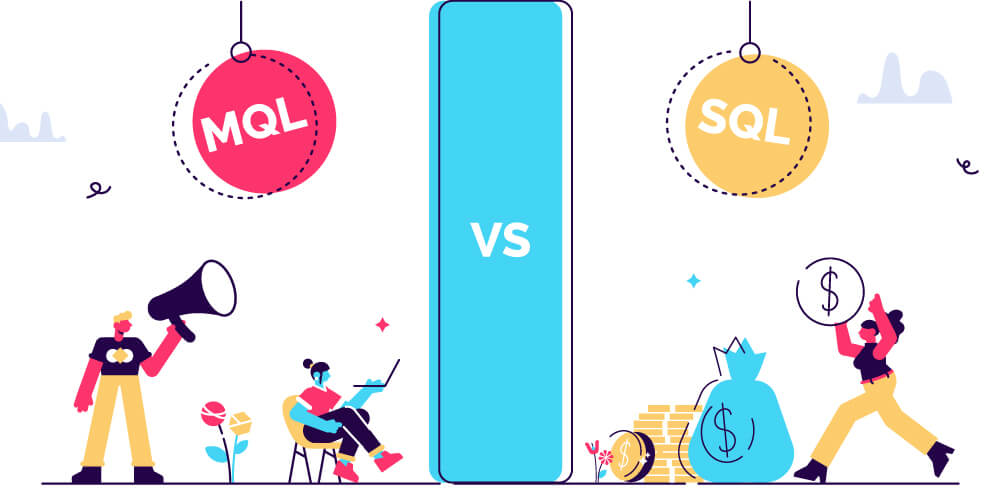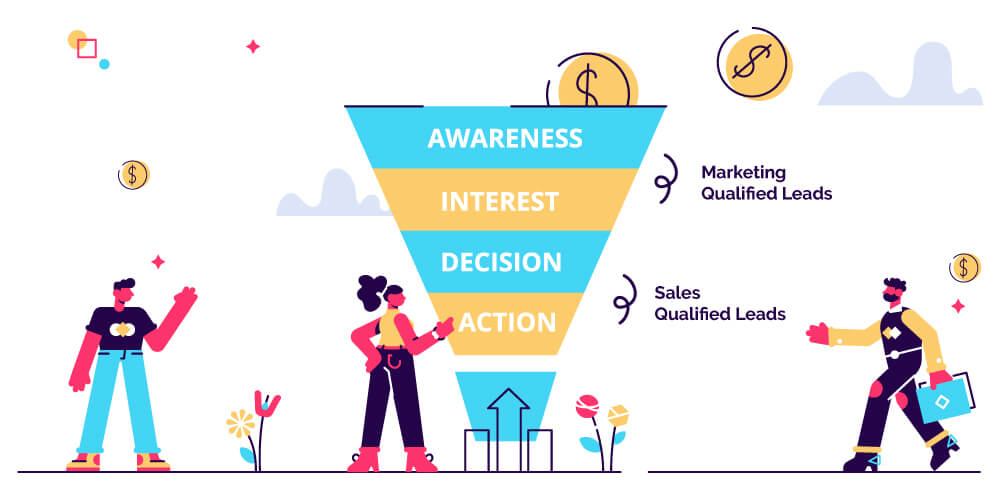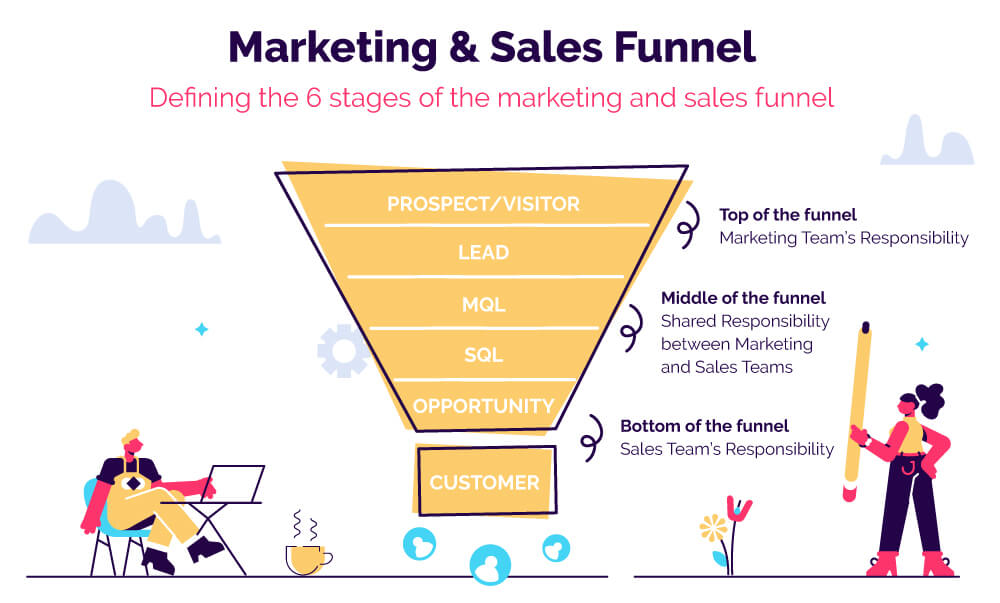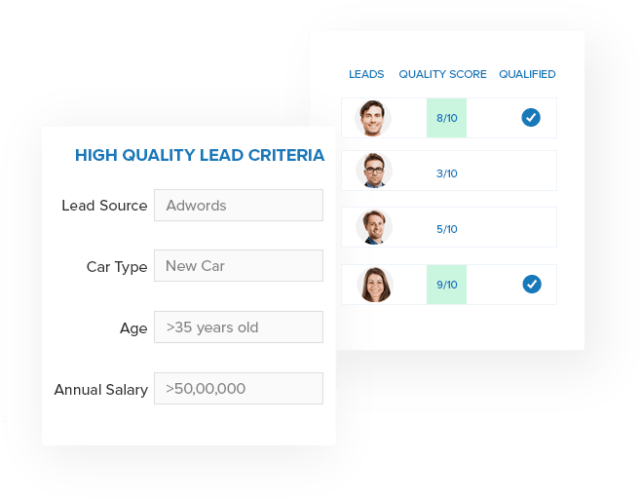MQL vs SQL: This article talks about what they are, how they differ, and why knowing their attributes is crucial to achieving your marketing and sales goals. All these will tie to converting more MQLs into SQLs to achieve better output from your efforts.
- MQL – Marketing qualified leads
- SQL – Sales qualified leads

Generating enough leads is, of course, a top challenge for marketers. But accurately assessing their quality is even a greater plight.
While generating more leads sounds lucrative, it may not be the best answer to every target shortfall. Generating leads without a based level of quality control often leads to organizations investing more to reach out to these leads, without many conversions.
You would not want your sales team to spend more time struggling to find the right type of lead to target. You want them to be productive and focus on what they know best – selling. Therefore, the best approach is to target a specific audience or formulate a process to convert volumes of MQLs into SQL.
We will talk about this in detail, but first, a quick look at the basics.
What is lead qualification?
On average, organizations generate 1,877 leads per month. But are all of them sales-ready? Not really.
Lead qualification is all about filtering your leads based on specific criteria. It involves prioritizing the most important ones and refining your lead generation strategies to boost your lead quality.
Generally, Lead qualification splits into two:
- Marketing qualified leads (MQL)
- Sales qualified leads (SQL).
Please note, Salesforce further splits these categories to create information qualified leads (IQL) as well. IQLs are relatively unfamiliar with your services and brands. Therefore, your IQL strategy closely relates to your brand awareness and other top of the funnel marketing campaigns.
However, going with the standards, we will focus only on MQLs and SQLs in this article.
Professionals state that knowing where your leads are in their customer journey helps them tune their messaging accordingly, which may even lead to faster conversions. It is because every lead is different. Not all of them will convert quickly to sales. Many might not even fit your product or service. According to Invesp, 80% of new leads don’t even translate into sales.
Nonetheless, MQL differs significantly from SQL, but they overlap sometimes. However, knowing the difference between them can help you rule out disqualified leads. It can also help you improve your marketing, sales, and conversion strategies. But how do you tell the difference?
What is a Marketing-Qualified Lead (MQL)?
MQL is a lead who has indicated an interest in your products/services based on marketing efforts. It is better than other leads (list imports, for example) and is more likely to become a customer. Usually, you qualify leads as MQLs by activities, behaviors, and specific demographics.
For instance, they might have interests in your guides, newsletters, jobs, check your pricing page, etc.
Also, note that even though MQLs are better than many other leads, they don’t guarantee sales. Often, they are not ready to talk to your sales reps yet. However, qualifying leads as MQLs makes it easier to focus your resources. That way, you can pay more attention to prospects with higher chances of conversion.
What is a Sales Qualified Lead?
A Sales Qualified Lead is a possible buyer. They are usually ready to discuss with your sales team. Generally, they might have shown interest in your product or service. Naturally, your marketing department must have nurtured, researched, and vetted these leads.
Also, note that you don’t have to discard leads that don’t qualify as SQLs. Sometimes, it needs a different strategy to influence them or develop an interest in your product/services.
MQL vs SQL: What’s the Difference Between MQL and SQL?
As mentioned above, MQL converts to SQL once they are ready to connect with your sales team. Yet, MQLs may have indicated an interest in your business. They may not be willing to buy at the moment, but they will respond to nurturing. Therefore, MQLs occur during the lead generation and early lead nurturing stages.

In contrast, your SQL may have asked for a one-on-one with your sales department. They may have also signed up for the demo of your product. In most cases, they reach such stages after your marketing team nurtured them. Therefore, SQLs occur further down the line in the sales funnel.
Factors that Determine your MQL and SQL Definitions
Every brand has different criteria for determining MQLs and SQLs. For some, SQL can be an inquiry. For others, it might be getting in touch with the brand directly. But a general mistake some brands make is failing to tell the difference. Such actions can disconnect your sales and marketing efforts. It means that you might spend more money and time on nurturing the wrong leads.

So, how do you move customers from MQL to SQL? Here are some conditions:
1. Lead demographics
When leads match your ideal customer profile, you might want to move them to your sales team. Such information goes beyond their age and job titles. It might also include information such as company size or industry and pain-points.
2. Lead scoring
Lead scoring combines many attributes to move MQL to SQL. It usually happens by assigning numerical values to your leads based on some predefined characteristics. It might take into consideration their demographic, firmographic and interest information, their engagement with your website and other assets across the internet, as well as their engagement with your emails and other communication campaigns. For instance, you can assign positive scores to leads who open your email, click on links, and negative scores for email bounce or unsubscribes.

3. Lead behavior
Lead behavior has to do with the actions that qualify leads as MQL or SQL. You must figure out what an ideal lead looks like and the influence a specific activity has in moving them down the funnel. It might include booking a meeting, taking part in a demo, or responding to an email. It might also include negative actions. For instance, if leads stop opening your emails or engaging with you, etc.
4. Likelihood to buy
To qualify a lead as SQL, they must be looking for a product or service. They must also have the budget or infrastructure to use it. Your product or service should also solve their pain points.
Tips to Convert Marketing Qualified Leads to Sales Qualified Leads
1. Align your Marketing and Sales Messaging
You should tune your marketing and sales teams. It plays a critical role in analyzing conversions correctly. Knowing your target market and their behaviors are essential, but consistent messaging throughout the sales-funnel is vital. It is because inconsistent messaging or providing overwhelming information may create confusion. In turn, it reduces trust and might even knock high value leads out of the sales funnel. Overall, aligning your marketing and sales increases the focus on high-quality leads. It ultimately leads to more conversions and sales.
2. Document Your Goals
It is crucial to document your goals and strategies to derive measurable results. Also note down your sales and marketing teams’ plans to contribute to those goals. The document should illustrate your company’s definitions for MQL, SQL, and processes for handling those leads. It will help each team member understand their roles. In short, it brings clarity to the process and improves performance and results.
3. MQL vs SQL: Always Prequalify Prospects
As mentioned, your MQLs differ from regular leads and can help reduce the costs of marketing. There is no need to overinvest resources in leads that aren’t your target. So always ensure that leads must meet your criteria for MQL or SQL. Accordingly, plan nurturing activities and move them down your sales funnel.
4. Consider the Sales Cycle
Every business has a unique sales cycle. You need to figure out yours so that you can make better decisions on MQL to SQL conversion. Your sales cycle can even affect your definitions of SQL for your business.
For instance, in some B2B scenarios, a prospect may want to get in touch with the salesperson but may not be ready to buy the product/service yet. In such cases, they will still need nurturing activities to qualify them for sales.
Watch the webinar: how to close more deals with effective sales management:
5. Evaluate Lead Sources
Analyzing your lead sources will also help you pre-determine the rates of conversion for leads originating from different channels or campaigns. For instance, leads from contact pages convert faster than from lead magnets (eBooks, whitepapers, etc.) forms. It is because prospects often contact you when they are halfway convinced about your products or services.
Some people might fill forms attached to your lead magnets for other purposes. For example, they might want to access the information, even though they don’t need your product. These people can be researchers, students, or even other marketers.
So, determine which pages on your website are essential for you from the sales point of view, and which campaigns are working the best to get high quality leads. Then, move leads from such pages (for example, your company’s contact pages) directly to the SQL phase.
On the flip side, you can nurture, analyze, and vet leads from lead magnets. You would like to understand their needs and refine your strategies as they transition. Lead scoring plays an important role here. Based on their engagement with your content, events, etc., you can automatically move them up and down the sales funnel. Alternatively, you can ask your inside sales teams to initiate conversations and qualify the leads.
CRM software helps a lot here. Software such as LeadSquared CRM allows you to automate workflows, track every interaction, and notify salespeople once they cross the qualification score.
6. Avoid Fudging the Numbers
Do not push leads instantly through the sales funnel to achieve high conversion rates. That only bogs your sales and marketing reps with lots of leads that may never pan out. Your criteria for MQL or SQL definition needs to be more selective. So always move your prospects to new stages using accurately defined data and attributes.
7. Personalize Interactions
After qualifying MQLs to SQLs, they are in the prime state of connecting with you. According to research, sales reps who follow up with leads within 5 minutes of inquiry/activity are 9x more likely to convert them. However, all follow-up strategies are not equal. Therefore, you need to use techniques that create meaningful and personal connections. You can increase the response rate by making automation a part of your lead generation and management processes. Evidence shows that marketing automation helps brands with a 451% increase in qualified leads. A VB Insight study reveals that 80% of marketers using automation generate a higher number of leads, and out of those, about 77% also convert more.
8. Analyze your Offerings, Messaging, and Scoring Metrics Regularly
Based on the market response, your strategies may need change, and this should reflect in your message, offerings, and scoring metrics. Regular analysis will help you identify barriers and evolve your messaging. Evaluating your scoring metrics will make sure they are still relevant. It helps you better understand what defines your MQL vs. SQL phases. Plus, you can identify other factors driving sales.
These metrics help assess the buyer’s position and the company’s relationship. They also evaluate your ability to influence their decision. You can also test your product or service’s strategic value against competitors. Altogether, you can determine the likelihood of conversions correctly.
Concluding Thoughts
In a perfect world, a person should instantly buy your product or service after learning about it. In reality, they want to know, like, and trust your brand before buying. The more complex your product and the higher the investment, the more time it takes to earn that trust. That is why businesses diligently focus on MQLs and SQLs.
However, failing to tell the difference between MQLs and SQLs creates a great danger. Leads don’t want sales reps to contact them before they are ready. If they are, they might become upset, leading to lost sales. HubSpot states only 19 percent of buyers would like to speak to a salesperson when still in the ‘awareness’ phase of their journey.
On the flipside, prospects ready to buy can also become annoyed when left in the nurturing stage.
Therefore, you must define the difference between MQL and SQL. Sure, it will depend on your formula and process for analyzing leads and your experiences with them. Finetuning the criteria for MQL and SQL will help you figure out what’s working and what isn’t. That way, you can better refine your overall marketing and sales strategy.









